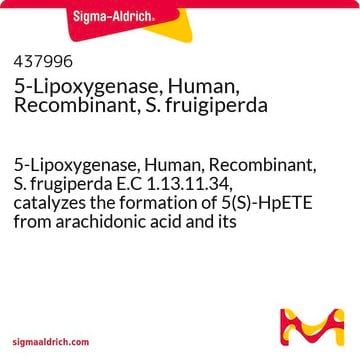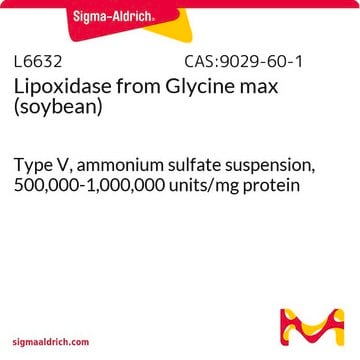SRP0410
ALOX15 active human
recombinant, expressed in baculovirus infected Sf9 cells, ≥60% (SDS-PAGE)
Synonim(y):
15LOX-1, arachidonate 15-lipoxygenase
Zaloguj sięWyświetlanie cen organizacyjnych i kontraktowych
About This Item
Kod UNSPSC:
12352202
NACRES:
NA.32
Polecane produkty
pochodzenie biologiczne
human
rekombinowane
expressed in baculovirus infected Sf9 cells
Próba
≥60% (SDS-PAGE)
Postać
aqueous solution
masa cząsteczkowa
75 kDa
opakowanie
pkg of 20 μg
numer dostępu NCBI
numer dostępu UniProt
Warunki transportu
dry ice
temp. przechowywania
−70°C
informacje o genach
human ... ALOX15(246)
Opis ogólny
The gene ALOX15 (arachidonate 15-lipoxygenase) is mapped to human chromosome 17p13. It is mainly present in the epithelial cells in the upper airways, reticulocytes, eosinophils and macrophages. ALOX15 belongs to the dioxygenases family. It is an IL-4 (interleukin 4)/IL-13 target gene.
ALOX-15, also known as 15LOX-1, ω-6 lipoxygenase, or arachidonate 15-lipoxygenase (GenBank Accession No. NM_001140) amino acids 2- 662 (end) with N-terminal FLAG-tag, MW = 75kDa, expressed in Sf9 insect cells via a Baculovirus expression system.
ALOX-15, also known as 15LOX-1, ω-6 lipoxygenase, or arachidonate 15-lipoxygenase (GenBank Accession No. NM_001140) amino acids 2- 662 (end) with N-terminal FLAG-tag, MW = 75kDa, expressed in Sf9 insect cells via a Baculovirus expression system.
Zastosowanie
Useful for the study of enzyme kinetics, screening inhibitors, and selectivity profiling.
Działania biochem./fizjol.
ALOX15 (arachidonate 15-lipoxygenase) is involved in homeostatic as well as pathological responses. ALOX15 is responsible for the oxidation of unsaturated fatty acids (at the 15 position) to active hydroperoxy and epoxy metabolites. It is also responsible for the conversion of linoleic acid to anti-tumor 13-S-hydroxyoctadecadienoic acid. ALOX15 is required for IL-4 (interleukin-4)/IL-13-mediated macrophage polarization. In mice, it is a negative regulator of bone mineral density. It is also involved in fatty acid metabolism. It controls MAPK (mitogen activated protein kinase) signaling in human airway epithelial cells using phosphatidylethanolamine-binding protein.
Postać fizyczna
Formulated in Tris-Buffered Saline (TBS), pH 7.4, containing 1 mM Fe(NH4)2(SO4)2.
Kod klasy składowania
10 - Combustible liquids
Klasa zagrożenia wodnego (WGK)
WGK 3
Temperatura zapłonu (°F)
Not applicable
Temperatura zapłonu (°C)
Not applicable
Certyfikaty analizy (CoA)
Poszukaj Certyfikaty analizy (CoA), wpisując numer partii/serii produktów. Numery serii i partii można znaleźć na etykiecie produktu po słowach „seria” lub „partia”.
Masz już ten produkt?
Dokumenty związane z niedawno zakupionymi produktami zostały zamieszczone w Bibliotece dokumentów.
Wen G Jiang et al.
Prostaglandins, leukotrienes, and essential fatty acids, 74(4), 235-245 (2006-03-25)
15-lipoxygenase (15-LOX) belongs to the structurally and functionally related nonheme iron dioxygenases family. It has two isoforms, type-1 (leukocyte type) and type-2 (epidermis type) and converts arachidonic acid to eicosanoids including the anti-cancer 13-HODE. In the current study, we investigate
15-Lipoxygenase 1 interacts with phosphatidylethanolamine-binding protein to regulate MAPK signaling in human airway epithelial cells.
Zhao J, et al.
Proceedings of the National Academy of Sciences of the USA, 108, 14246-14246 (2011)
12/15 Lipoxygenase regulation of colorectal tumorigenesis is determined by the relative tumor levels of its metabolite 12-HETE and 13-HODE in animal models.
Chang J, et al.
Oncotarget, 6, 2879-2879 (2015)
Polymorphisms in inflammation associated genes ALOX15 and IL-6 are associated with bone properties in young women and fracture in elderly.
Herlin M, et al.
Bone, 79, 105-105 (2015)
E Sigal et al.
Biochemical and biophysical research communications, 157(2), 457-464 (1988-12-15)
A full-length cDNA encoding 15-lipoxygenase has been isolated from a human reticulocyte cDNA library. The predicted primary structure of the enzyme exhibits a sequence similarity of 61% and 45% with human 5-lipoxygenase and the soybean lipoxygenase isoenzyme I, respectively. When
Nasz zespół naukowców ma doświadczenie we wszystkich obszarach badań, w tym w naukach przyrodniczych, materiałoznawstwie, syntezie chemicznej, chromatografii, analityce i wielu innych dziedzinach.
Skontaktuj się z zespołem ds. pomocy technicznej








